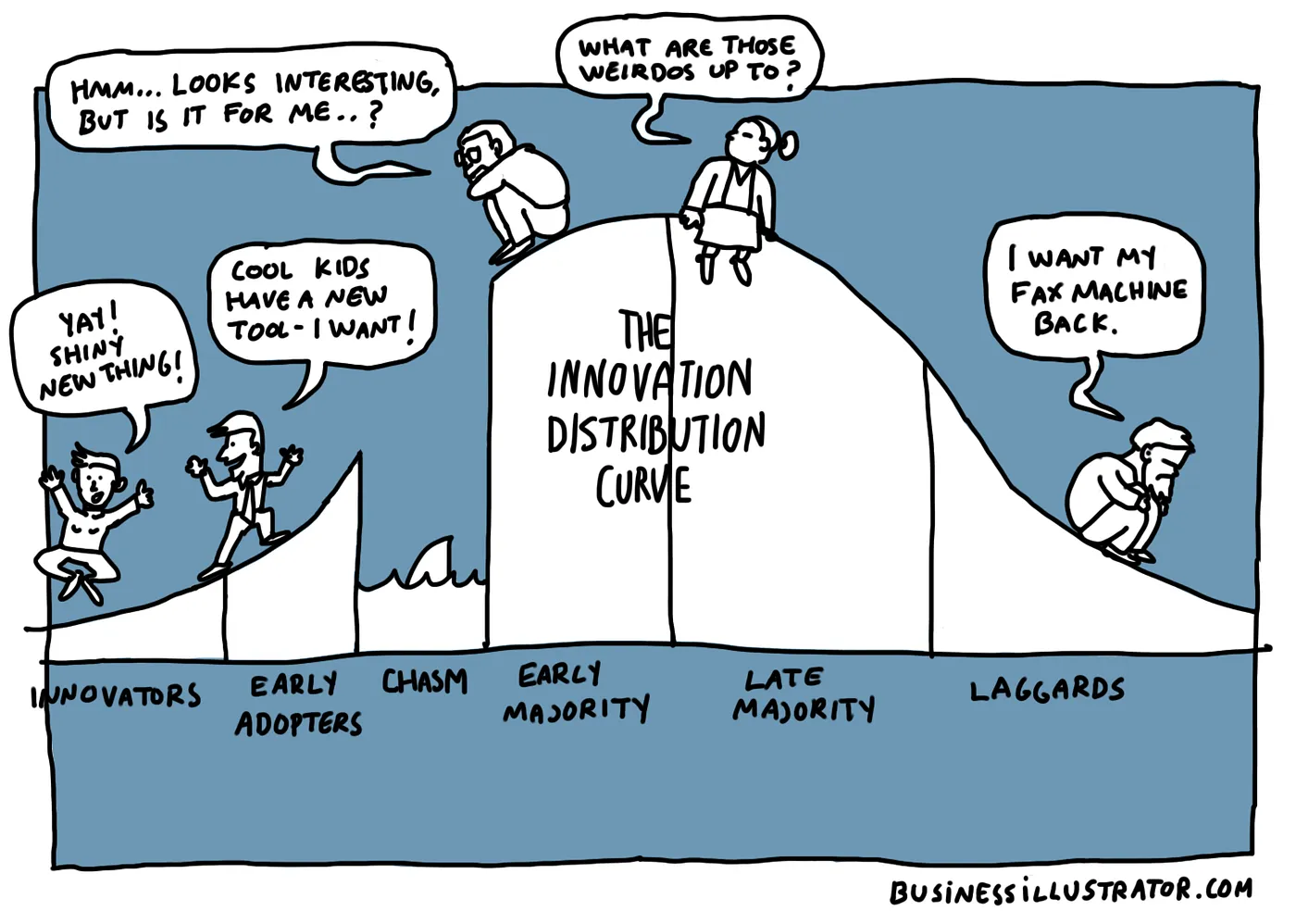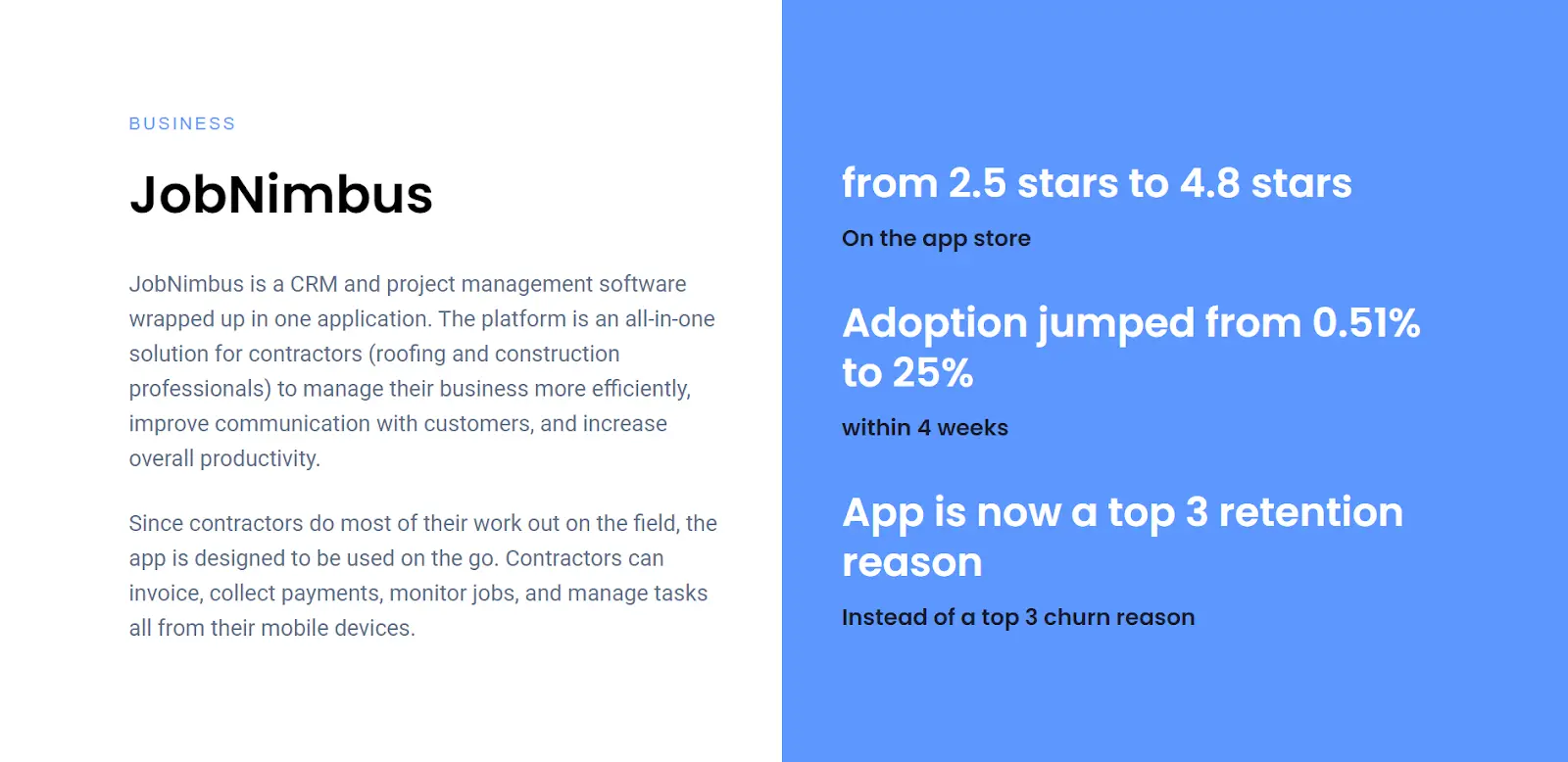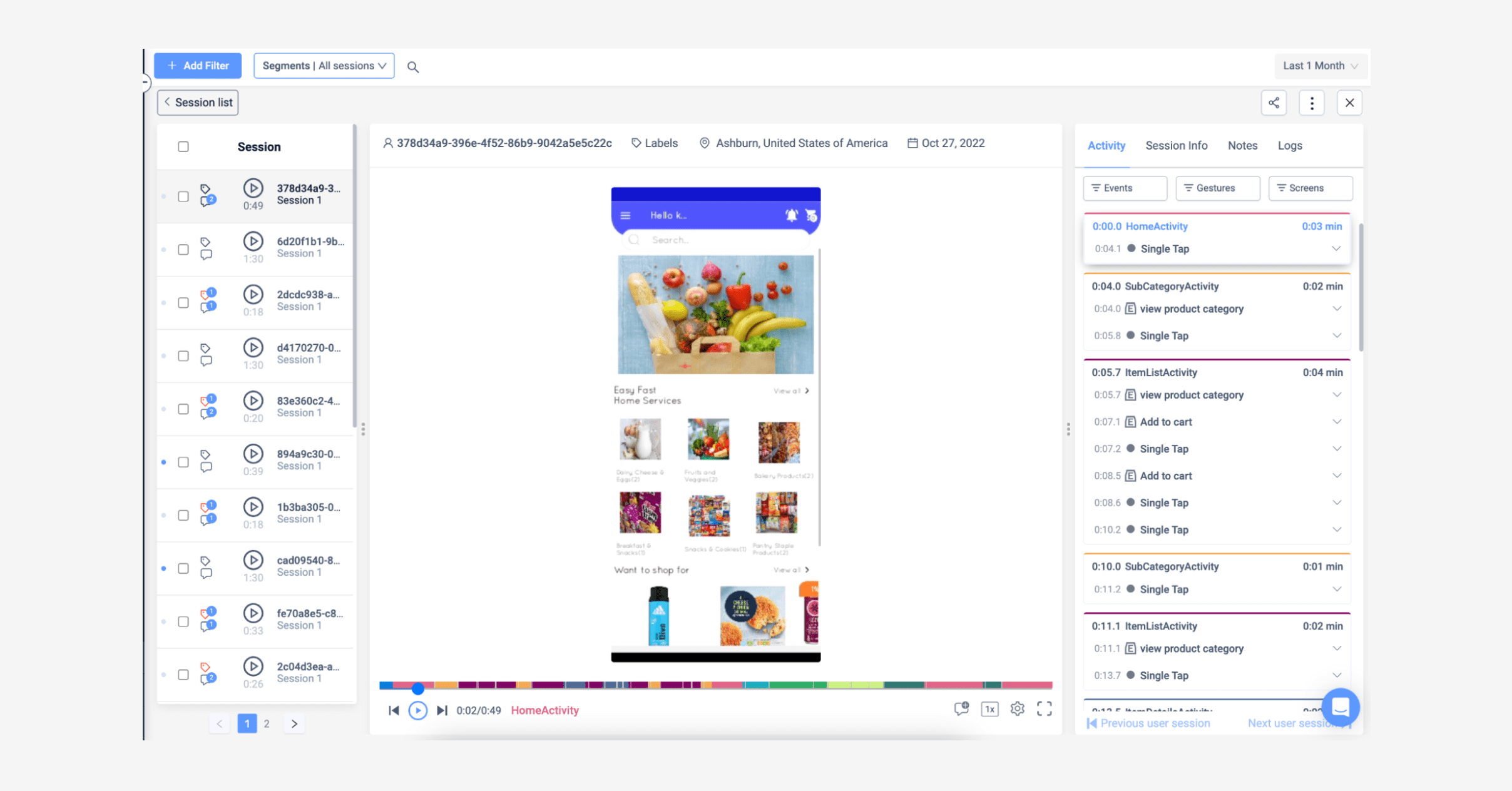Back to blog
7 MIN READ
Stages of the Product Adoption Process - An Indepth Guide
PUBLISHED
1 November, 2023

Product Analytics Expert
Product adoption is a major hurdle every mobile product team needs to clear (and keep clearing) to succeed long term.
Understanding and mastering the stages of the product adoption process is vital to building a thriving mobile product. And in this UXCam guide, we’ll discuss each stage in detail, giving you insights into how users think and act throughout their journey with your product.
Ready to start winning loyal users? Let’s dive in.
What is the product adoption process?
The product adoption process is the sequence of steps that users go through when they start to learn about a new product, decide whether to use it, and ultimately become regular users.
The product adoption process is a formula used to convince people to use products. Adoption is critical as it empowers users to discover that a product is usable and valuable, turning them into long-term customers and brand advocates.
The product adoption process is usually split into five stages:
Awareness
Interest
Evaluation
Trial
Adoption
Users need different things at each stage, and if you can give them what they need when they need it, they’ll be more likely to move through the funnel and become loyal customers.
The product adoption curve
The road to adoption is dynamic. Throughout your product lifecycle, you’ll face different types of adaptors. Each group is defined by a different relationship to change, novelty, and risk.

Here’s an overview of the five most common:
Innovators (2.5%): This group is always the first group interested in trying new features and products. But this love of all things new makes it more difficult to turn them into long-term loyal customers. This group will also likely be your first opportunity for user feedback at scale.
Early Adopters (13.5%): This group is the second to arrive at that party. They expect products to be more polished and stable than innovators but can still put up with change.
Early Majority (34%): This group is the first significant wave of users. They are more cautious and will take their time to research a product before adopting it. As a result, they’re more likely to stick around once you’ve won them over.
Late Majority (35%): This group is similar to the early majority but is slower to adopt and often requires more hand-holding. They want to make sure that your product is going to work for them before committing.
Laggards (16%): This group is the most resistant to change. They prefer the product they already use and will only change if you make an incredibly compelling case (or if their existing product changes too much).
Benefits of understanding the product adoption process
Product adoption is one of the most critical business goals for mobile product teams. And understanding the process is the only way to achieve it reliably. When you understand the different stages of the process, you can better craft your product messaging to match each stage.
This leads to all kinds of benefits, including:
Increased customer retention
Increased business revenue and growth
Stronger market position
More cost-effective acquisition
Easier upselling
Enhanced the UX and CX
For example, consider JobNimbus.

The team used UXCam’s mobile analytics tools to understand why users weren’t adopting their mobile app. Through session replays, heatmaps, and event logs, they uncovered a range of pain points that created friction at key moments.
By redesigning their app, the team boosted product adoption by 25% in four weeks.
5 Stages of the product adoption process
1. Awareness (the introduction stage)
Customers become aware of your product’s existence. They’ve heard about it but do not know if it can solve their problems—or that they have a problem in the first place. They need to be explicitly introduced because they are pretty much dismissive of the product at this stage.
How to influence and engage prospects at the awareness stage:
Create content. Choose a target adoption group and create content about their pains and interests.
Use diverse channels. Don’t just stick to one channel for distributing content—go to where your prospects are. Targeting bootstrapped SaaS founders? Try indie-software forums. Targeting enterprise customers? Try industry conferences or trade shows.
Prioritize web presence. Invest in creating a website that speaks to prospects at the awareness stage. Make sure it emphasizes your product’s values and features for solving their pain points.
Encourage word-of-mouth. Ask satisfied customers to spread the word about your product. Consider incentivizing them with discounts, referral programs, or other rewards.
Track effectiveness. Track how efficient your methods are with mobile app KPIs like the number of sign-ups or new active users.
2. Interest (the information gathering stage)
If your product awareness strategy is effective, your target prospects will begin to develop interest and thus perform research.
The information they seek to learn more about why your product is the right solution for them will depend on the following:
Their adaptor type
Their intended use cases
And your products’ features, functionality, quality, characteristics, branding, and customer care information.
Interested people will typically look at your marketing materials and read customer reviews to learn what others think.
How to influence and engage prospects at the interest stage:
At this stage, people are trying to get a baseline understanding of your product—what it is, what it does, what the benefits are, when it’s useful, etc. The way you engage prospects at this stage is by making sure all the information they’re looking for is readily available.
You can do this through:
Explainer videos
User guides
Feature breakdowns
Demos
How-tos
Your main mediums are your website, app store listing, and social media. As prospects research, you want to make sure that all the necessary information is clear and easy to understand so they can quickly form a positive opinion about your product.
3. Evaluation (the consideration stage)
At this stage, prospects are trying to decide if your product is the right fit for them. This is a detail-oriented process that goes beyond understanding what your product does. Their goal is to get a holistic understanding of how your product would work for them.
Will it integrate with a tool they use? Will they be able to migrate their data? Is the onboarding process straightforward? You need to be able to help prospects answer these questions.
How to influence and engage prospects at the evaluation stage:
Like the previous two stages, content is key. You should have detailed content that covers topics such as pricing, technical requirements, and integrations.
You can also create more interactive experiences like demos or personalized product tours to give prospects a better feel for the product. Additionally, you can offer free trials or tests so prospects can try out your product without commitment—but more on that in a minute.
4. Trial (the sampling stage)
At this stage, your prospects are ready to test your product and draw their conclusions. They may try a free trial but aren’t regular users yet. They may also watch a demo or make a purchase.
This stage involves your prospects testing your product to answer questions like:
Does it meet my requirements?
Does it integrate seamlessly with my tech stack?
Is it easy to use?
Is it better than the competition?
Your customers-to-be will pay special attention to see whether your product delivers the selling points.
How to influence and engage prospects at the trial stage:
It’s essential to set your potential new user up for success—any tiny mistake matters at this stage and could cost you a customer. Arrange for your customer success team to check in with them to see if they're having the best possible experience. If not? Talk to them about potential solutions.
In addition to reaching out to customer, you should also be using an analytics tool like UXCam to collect data on their experience.Our platform delivers powerful qualitative and quantitative analytics based on natural user behavior.


Use session replays, heatmaps, funnels, and user journey maps to uncover friction points and bottlenecks in the user experience. Make data-driven decisions and optimize your app design for higher engagement and better retention.
5. Adoption (the transition stage)
Finally, we have the adoption stage. This is where users have their a-ha moments—understanding the value of your product and how it can help them.
To communicate the tangible benefits of your product, create a great onboarding experience that educates users on the best practices for using your software. Use incentives to encourage adoption and reward users as they progress in their journey. Finally, highlight their successes through statistics, reports, and KPIs.
For example, the popular security-focused browser Brave gives app users a real-time estimate of the time they’ve saved using the product. Accumulated time savings are displayed as a badge, providing users instant gratification and recognition for their efforts.
How to influence and engage prospects at the Adoption stage:
Signpost the happy path. Guide users to success by providing access to support resources and tutorials.
Make onboarding more engaging. Offer interactive onboarding experiences that are fun, meaningful, and easy to follow.
Celebrate milestones and success. Show appreciation when users complete key stages in the onboarding process. Give users concrete examples of the benefits of using the product.
Track progress toward goals. Monitor usage data and user feedback to give users real-time insights into their progress.
Offer rewards for accomplishments. Provide incentives such as discounts, badges, or points when users reach key milestones or complete specific tasks within the app.
Get Your Product Use With UXCam
If no one is using your app, then it’s not successful.
Product adoption is transitioning from a user being foreign to a product to accepting and using it regularly. This process is critical to sustaining business growth and is mainly supported by a deep understanding of the people you’re trying to convince.
UXCam supports mobile product teams to enhance functionality, design, and value to get prospects to the adoption phase and become loyal quickly. Our analytics help you to understand users meticulously so you can design intuitive user flows that keep them discovering new functionality while keeping them hooked.
See why thousands of leading mobile app brands choose us to support their product adoption strategies by requesting a demo or starting your free trial today.
You might also be interested in these;
How to analyze session recordings
How to measure product adoption (metrics, formulas & tools)
AUTHOR

Tope Longe
Product Analytics Expert
Ardent technophile exploring the world of mobile app product management at UXCam.
What’s UXCam?
Related articles
App Analytics
Mobile App Tracking: Practical Guide & Best Tools [2026]
The best tracking tools for mobile...

Jonas Kurzweg
Product Analytics Expert
App Analytics
Top Analytics SDKs 2026
Pick the right analytics SDKs to improve your app's...

Jonas Kurzweg
Product Analytics Expert
Product best practices
8 Best UX Analytics Tools and Software We’ve Tested 2025
A good UX design is key when it comes to user satisfaction. Learn about five of the best UX analytics tools you can use to get valuable insights about user...

Jonas Kurzweg
Product Analytics Expert


